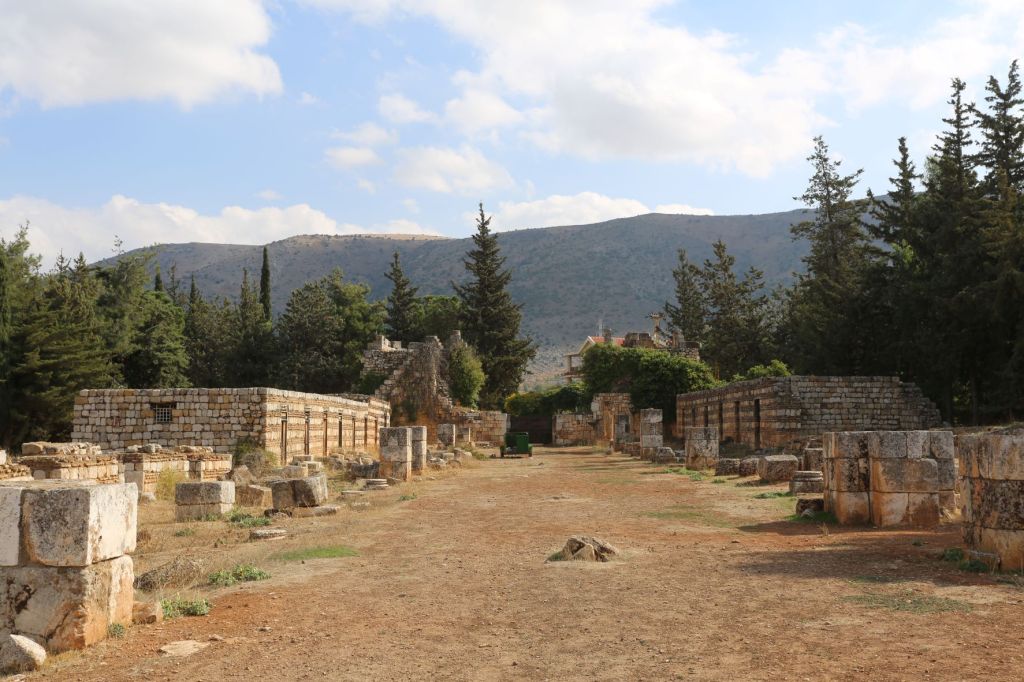While we had a lot of time in the largest city and capital Beirut, more to see in the country. We scratched the surface, visiting the highlights, but there’s a great deal more that awaits us if we return. It’s a small country (a bit smaller than Connecticut; for comparison, Jordan is about the size of Maine; Italy is roughly Arizona; and Egypt is 50% bigger than Texas) so you can get to all corners with day trips from Beirut, which is very centrally located.
We drove up the coast to the ancient Phoenecian settlement of Byblos. Our guide Tony explained about the many layers of civilizations that have been excavated in the area, dating back 8,000 years. Byblos currently boasts a couple of Crusader-era forts, a Roman amphitheater, and a Neolithic village dig site.



We then drove back south toward the city, and rode up to the mountains immediately above via a cablecar, which afforded incredible views of Beirut and the Mediterranean.


Our first day tour finished with a stop by the Jeita Grotto, a famous cave site full of unbelievable stalactites and stalagmites (holds its own against Carlsbad Caverns in NM, which we saw earlier this year). No pictures allowed inside 😦
Jenn’s been feeling a bit unwell for all of this leg, so I went on my own to a prearranged cooking lesson followed by dinner at the host’s house. I’m not a whiz in the kitchen and this activity is more up Jenn’s alley, but we didn’t want to cancel on Tania as she depends on the money from this side hustle keep afloat. Tania is a technically trained government employee, whose nominal government salary is the equivalent of less than US$100 per month. In addition to classes, she produces food for her pop up store and local markets to supplement.
Jenn was very sad to not be able to go, so the B Team had to hold up the family name. Yikes.






I helped prep for about 3.5 hours, during which time I avoided injury, learned a few things and dirtied to stay out of the way while filming for Jenn. We enjoyed a nice meal with Tania, her parents (her mom also helped cook), one of her brothers, and three friends. It was a fun, boisterous meal with a dash of arak, the local anise-flavored spirit, mixed in as well. Afterward, I brought home a bunch of food that Jenn enjoyed. (She’s feeling better now, btw.)
Our last day centered on a driving tour with our guide Tony to some of the ancient sites around the country. We drove over the coastal mountains to the Bekaa Valley, a fertile region similar to California’s central valley. It was noticeably cooler as we were at some elevation.
Our first stop were the Umayyid ruins at Anjar, which is only about 3 miles from the Syrian border (see footnote 1). These were likely built on top of older Roman ruins (which themselves were atop Greek, which were atop Phoenician, atop probably something else). These were nicely restored, and the site was in fact home to the Syrian army when it occupied parts of Lebanon during the civil war.





Over that hill: Syria
Those were impressive, and the setting, amongst a pine forest, was unique among the ruins we’ve seen.
Our next stop at Baalbek was jaw-dropping
Arguably the largest and best-preserved Roman era ruins in the world (including those in Italy), the site was huge. What makes it a treasure is the condition of the Temple of Bacchus, which retains most of its columns but also the carved stone ceiling between the main building and the surrounding columns. Simply incredible, and we had it to ourselves!











The detail was magnificent. Oh, and the engineering feat to raise these enormous, elaborately carved blocks atop pillars 100 feet above ground? Beyond belief.
Jenn and I have seen more than our share of Roman ruins, and I don’t think anything tops this (the Colisseum was spectacular, but Baalbek was mind-blowing). And we had it more or less to ourselves, which while great for us was kind of a shame. Hopefully more people can visit this amazing place.
Finally, we had time to stop at a local winery. Franciscan monks started the winery in the 19th century, and it’s now in private hands. The setting was lovely, the wine was pretty good.



We sincerely hope that Lebanon gets a number of years of peace and quiet to sort themselves out, that other powers in their neighborhood support them, and that they can realize the vast potential the country has to be a fascinating and prosperous land.
And so we flew out the next morning, via Athens to our next and last destination, another country in the Middle East.
(1) On our drive we saw a number of refugee settlements, which have their own history and whose presence creates some consternation with the Lebanese. The UN payments to the refugees often add up to more than what local Lebanese make, as the payments are in USD. Further, the refugees can also get jobs, and so take a lot of positions from locals b/c the refugees aren’t as fussed about their wages. The system (as described to us) would naturally create resentment by the local Lebanese. Lebanon has roughly 2 million refugees, versus a regular population of 4.5 million.
